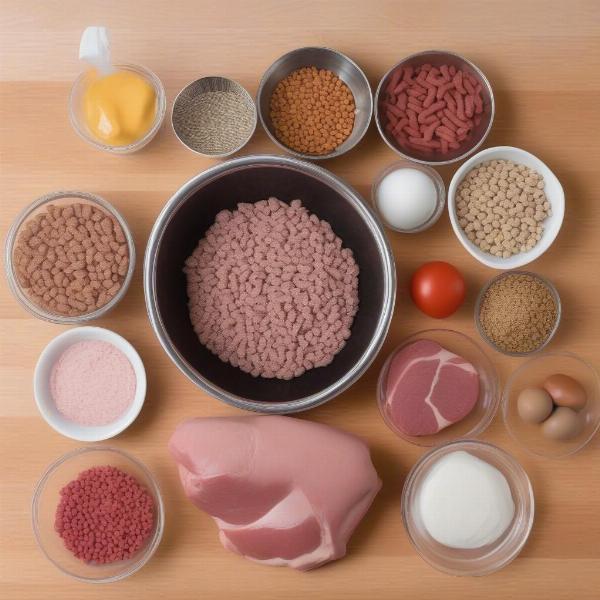Feeding your dog a raw diet can be incredibly beneficial, but it can also be perceived as expensive. Many dog owners are interested in exploring the least expensive raw dog food options to provide their furry friends with the best nutrition without breaking the bank. This article will guide you through creating affordable and healthy raw meals for your dog, focusing on sourcing ingredients economically and preparing balanced meals.
Sourcing Affordable Ingredients for Raw Dog Food
Finding budget-friendly ingredients is key to making raw feeding sustainable. Don’t be afraid to think outside the box!
- Local Butchers and Farmers: Building relationships with your local butcher can often lead to discounts on organ meats and less desirable cuts, perfect for raw feeding. Farmers markets can also be a great source of affordable, seasonal produce.
- Grocery Store Sales: Keep an eye on weekly flyers and stock up on discounted meats when available. Freezing allows you to buy in bulk and save money.
- Online Retailers: Some online retailers specialize in pet food and offer bulk discounts on raw ingredients. Compare prices and look for deals.
- Consider Less Popular Cuts: While prime cuts are tempting, less popular cuts like chicken thighs, beef hearts, and pork shoulder are nutritionally rich and often significantly cheaper.
Creating Balanced Meals on a Budget
Balancing your dog’s raw diet is crucial, even on a budget. Here’s how to ensure your dog receives all the necessary nutrients:
- The 80/10/10 Rule: A good starting point is the 80/10/10 rule: 80% muscle meat, 10% bone, and 10% organ meat (half of which should be liver).
- Supplements: While a well-balanced raw diet often minimizes the need for supplements, adding a dog food with least ingredients can provide a safety net for essential nutrients.
- Variety is Key: Rotate protein sources (chicken, beef, turkey, fish) to provide a wider range of nutrients and prevent deficiencies.
- Don’t Overfeed: Follow recommended feeding guidelines based on your dog’s breed, age, and activity level. Overfeeding is wasteful and can lead to health issues.
 Balanced Raw Dog Food Meal Prep
Balanced Raw Dog Food Meal Prep
What is the cheapest meat to feed a dog raw?
Chicken, especially less desirable cuts like backs, necks, and frames, is often the cheapest meat for a raw dog food diet. Pork and beef, particularly organ meats, can also be affordable options.
Can I make raw dog food cheaper than kibble?
While it can be challenging, making raw dog food cheaper than kibble is possible, especially if you source ingredients wisely and prioritize less expensive cuts of meat.
What are some common mistakes to avoid when feeding raw on a budget?
Avoid sacrificing nutritional balance for cost. Ensure your dog is receiving adequate bone, organ meat, and a variety of protein sources. Don’t rely solely on muscle meat.
Is a raw food diet truly healthier for dogs?
Many proponents of raw feeding argue it’s closer to a dog’s ancestral diet and provides benefits like improved coat health, increased energy, and better digestion. However, it’s crucial to consult with your veterinarian to determine if a raw diet is suitable for your dog’s specific needs.
Conclusion
Feeding your dog the least expensive raw dog food doesn’t mean compromising on quality. By focusing on smart shopping, utilizing a variety of affordable ingredients, and prioritizing nutritional balance, you can provide your dog with a healthy and delicious raw diet without emptying your wallet. Remember to consult with your veterinarian before making any significant dietary changes for your dog.
FAQ
- Is it safe to feed my dog raw chicken? While raw chicken can contain bacteria like Salmonella, freezing can significantly reduce the risk. Proper hygiene practices when handling raw meat are also essential.
- How much raw food should I feed my dog? The amount varies depending on your dog’s breed, age, activity level, and overall health. Consult your veterinarian for personalized recommendations.
- Do I need to supplement a raw diet? A balanced raw diet minimizes the need for supplements, but adding a dog self feeder can ensure your dog is getting enough food throughout the day. It’s best to discuss supplementation with your veterinarian.
- What if my dog doesn’t like raw food at first? Transitioning to raw food gradually can help your dog adjust. Start by mixing small amounts of raw food with their current diet and gradually increase the proportion.
- Where can I find more information about raw feeding? Consult with a holistic or integrative veterinarian specializing in raw feeding. They can provide tailored guidance and resources.
Expert Insights:
- Dr. Emily Carter, DVM: “Raw feeding can be a great option for many dogs, but it’s essential to focus on balance and hygiene. Don’t be afraid to explore budget-friendly options!”
- Sarah Miller, Canine Nutritionist: “Variety is crucial in a raw diet. Rotating protein sources ensures your dog receives a wide spectrum of nutrients and minimizes the risk of deficiencies.”
- John Davis, Experienced Raw Feeder: “Building a relationship with your local butcher can be invaluable for sourcing affordable raw ingredients.”
Related Articles:
About ILM Dog:
ILM Dog is your trusted international resource for comprehensive dog care and nutrition advice. We provide expert guidance on breed selection, health, training, nutrition, grooming, and much more. We are dedicated to helping you provide the best possible care for your canine companion. Whether you’re a seasoned dog owner or just starting your journey, ILM Dog is here to support you every step of the way. Contact us at [email protected] or +44 20-3965-8624 for personalized advice and resources.